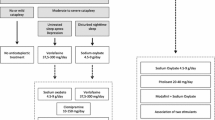Abstract
Cataplexy is a sudden drop of antigravity-muscle tone triggered most often by positive emotional factors, which is one of the major symptoms of narcolepsy. Cataplexy has been treated pharmacologically, most often with tricyclic antidepressants. Even though tricyclic antidepressants are effective in reducing sleep paralysis and hypnagogic hallucinations, they even enhance daytime sleepiness, dizziness, and orthostatic hypotension. We assessed the anticataplectic effect of milnacipran, an SNRI, on human and canine narcolepsy. We also assessed the effect of milnacipran on REM sleep suppression in nocturnal sleep. Ten human patients with narcolepsy–cataplexy who changed medication from clomipramine to milnacipran due to side effects were enrolled. The change in the frequency of cataplexy and side effects before and after drug replacement was investigated. To assess milnacipran’s depressant effect on REM sleep, we performed nocturnal polysomnography examinations twice on each eight healthy adult subjects who were administered with milnacipran or placebo. In the study on canine narcolepsy, four genetically narcoleptic Doberman pinschers were enrolled. The food-elicited cataplexy test was used to assess the anticataplectic effect of milnacipran. Milnacipran significantly reduced cataplexy from 9.3 to 5.5 episodes per month in human patients without much side effects. The percentage of REM sleep significantly decreased (p = 0.042) in the subjects with milnacipran (17.5 ± 1.7%) compared to subjects with placebo (21.5 ± 2.3%). Milnacipran also significantly reduced cataplexy dose-dependently in the study on canine narcolepsy. Milnacipran reduced cataplexy in human patients and REM sleep in healthy human subjects. Our study contributes further to previously reported role of adrenergic uptake inhibition in cataplexy. This compound had less side effect than those of tricyclic antidepressant, clomipramine.


Similar content being viewed by others
References
Nishino S, Arrigoni J, Shelton J, Dement WC, Mignot E. Desmethyl metabolites of serotonergic uptake inhibitors are more potent for suppressing canine cataplexy than their parent compounds. Sleep. 1993;16(8):706–12.
Takenoshita S, Nishino S. Pharmacologic management of excessive daytime sleepiness. Sleep Med Clin. 2020;15(2):177–94.
Nishino S, Fruhstorfer B, Arrigoni J, Guilleminault C, Dement WC, Mignot E. Further characterization of the alpha-1 receptor subtype involved in the control of cataplexy in canine narcolepsy. J PharmacolExpTher. 1993;264(3):1079–84.
Nishino S, Reid MS, Dement WC, Mignot E. Neuropharmacology and neurochemistry of canine narcolepsy. Sleep. 1994;17(8 Suppl):S84-92.
Nishino S, Mignot E. Pharmacological aspects of human and canine narcolepsy. ProgNeurobiol. 1997;52(1):27–78.
Akimoto H, Honda Y, Takahashi Y. Pharmacotherapy in narcolepsy. Dis NervSyst. 1960;21:704–6.
DeVane CL. Differential pharmacology of newer antidepressants. J Clin Psychiatry. 1998;59(Suppl 20):85–93.
Scammell TE. Narcolepsy. New Eng J Med. 2015;373(27):2654–62.
Sulser FMP. Biochemical effects of antidepressants in animals. In: Hoffmeister FSG, editor. Psychotropic agent: antipsychotics and antidepressants, handbook of experimental pharmacology. Berlin: Springer-Verlag; 1980. p. 471–90.
Ross SB. Interactions between reserpine and various compounds on the accumulation of [14C] 5-hydroxytryptamine and [3H]noradrenaline in homogenates from rat hypothalamus. BiochemPharmacol. 1979;28(7):1085–8.
Fuller RW, Perry KW. Increase of pineal noradrenaline concentration in rats by desipramine but not fluoxetine: implications concerning the specificity of these uptake inhibitors. J Pharm Pharmacol. 1977;29(11):710–1.
Mochizuki D, Tsujita R, Yamada S, Kawasaki K, Otsuka Y, Hashimoto S, et al. Neurochemical and behavioral characterization of milnacipran, a serotonin and noradrenaline reuptake inhibitor in rats. Psychopharmacology. 2002;162(3):323–32.
Lemoine P, Faivre T. Subjective and polysomnographic effects of milnacipran on sleep in depressed patients. Hum Psychopharmacol. 2004;19(5):299–303.
Hasegawa E, Maejima T, Yoshida T, Masseck OA, Herlitze S, Yoshioka M, et al. Serotonin neurons in the dorsal raphe mediate the anticataplectic action of orexin neurons by reducing amygdala activity. ProcNatlAcadSci USA. 2017;114(17):E3526–35.
Funding
This research was supported by Japan Agency for Medical Research and Development (Grant JP20dm0107162) and Japan Society for the Promotion of Science (Grant 19K08037).
Author information
Authors and Affiliations
Corresponding author
Additional information
Publisher's Note
Springer Nature remains neutral with regard to jurisdictional claims in published maps and institutional affiliations.
Supplementary Information
Below is the link to the electronic supplementary material.
Rights and permissions
About this article
Cite this article
Kaneko, Y., Inoue, Y., Fujiki, N. et al. The anticataplectic and REM suppression effect of milnacipran, an SNRI, on human and canine narcolepsy. Sleep Biol. Rhythms 19, 137–143 (2021). https://doi.org/10.1007/s41105-020-00298-2
Received:
Accepted:
Published:
Issue Date:
DOI: https://doi.org/10.1007/s41105-020-00298-2




